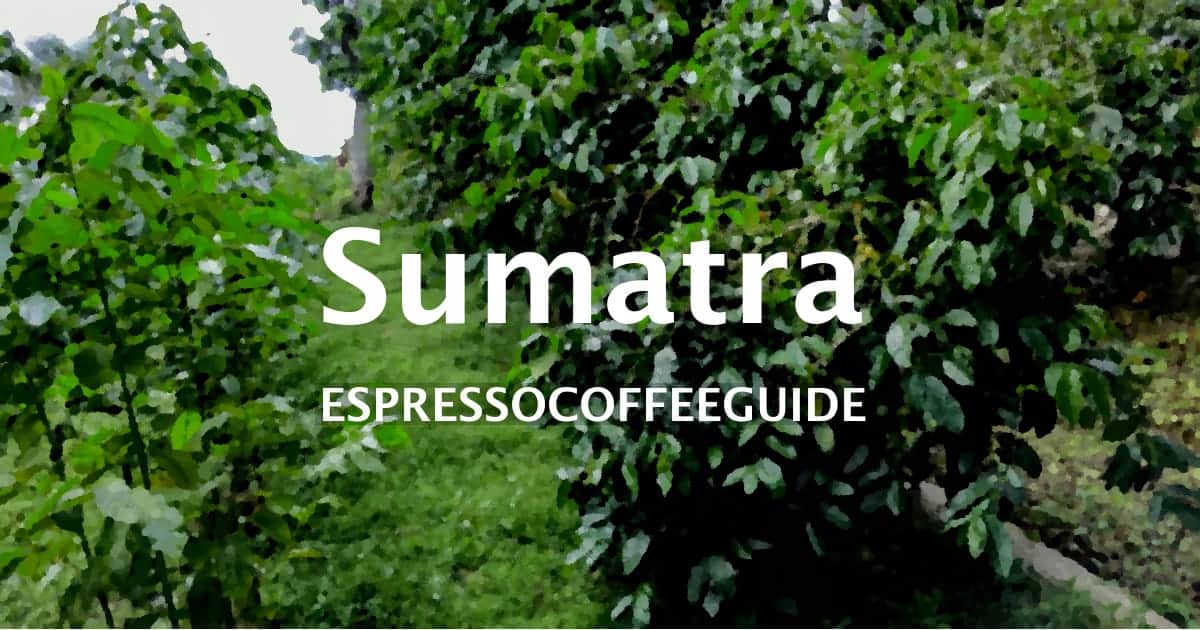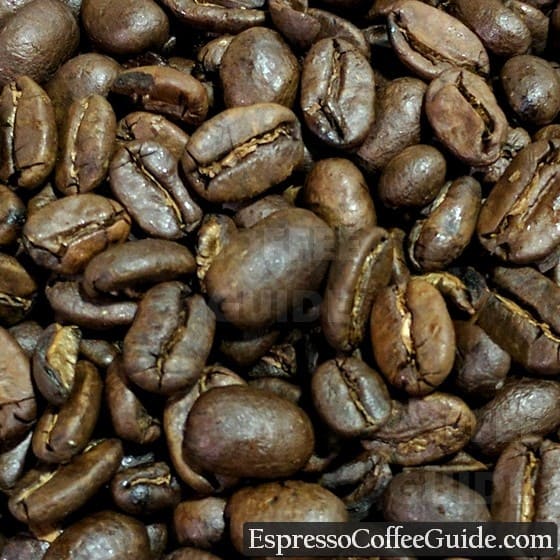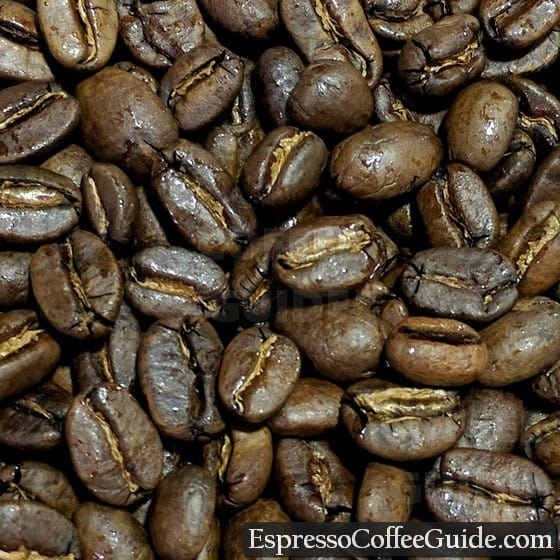
Some of the world's best tasting premium gourmet coffees are Mandheling, Ankola, and Lintong grown in Sumatra. These coffees are distinguished by their full body, more earthy flavours than Java Arabica, distinct herbal tones, and with a low acidity. This low acidity makes them particularly attractive for people who have a sensitivity to the otherwise healthy organic acids in coffee.
Sumatran coffees are well reviewed and renown world-wide for providing a rich, satisfying flavor, though this can be overwhelming for the uninitiated.

Jump to:
Tasting Notes
Sumatra Mandheling Coffee, grown in the west-central region near Padang, is known for its smooth and heavy body that is sometimes even described as syrupy. The best Sumatran coffees have a relatively low acidity, but just enough to provide add interest to the complex tastes. Mandheling often exhibits intense sweet tones of chocolate, and sometimes notes of licorice and other spice-based flavors. Note that spices here typically refers to herbs - cinnamon, nutmeg, cardamom, etc and not scoville-units of heat.
The best Sumatran green coffees are grown at an elevation between 2,500 and 5,000 feet (760 to 1,520 meters), qualifying some as Strictly High Grown (SHG), but not all.
Lintong Region
Lintong coffee is sweet with a medium body, low acidity, an earthy, complex aroma, and a unique cedar and spice flavour not found in any other coffee. Sumatra Lintong is grown in north central region of the island of Sumatra near Lake Toba in the Lintongnihuta region, which has the altitudes necessary for Arabica coffee cultivation. High quality Lintongs are distinguished from their regional relatives by their clean acidity and brighter acidity, as well as lesser mouthfeel (still considered a medium body).
Aceh Region
The region of aceh is one of the few in the world that offers an aged coffee - typically stored for months or years to allow the flavor to change and develop instead of being sold on the market immediately. This extra care has a cost associate with it (some spoilage, some storage, some administrative) and usually results in a slightly higher price point. While the flavour isn't better or worse than a regular Sumatra per se, it is valued for it's complexity and rarity among aficionados.
While the region of Aceh and Lintong produce coffees that are sought-after, Lampung hasn't seen much acitivity from importers. brokers and wholesalers in recent years, making it difficult to find on the market. Mandheling coffees are frequently sought after by foodservice distributors for their distinctively complex flavour, which is perceived as being an exotic experience at restaurants and cafes.
Gayo Region
The Gayo region includes the highlands surrounding the Gayo Mountain and Lake Tawar, found from 1,300 - 1,600 meters above sea level. These coffees typically use the "Gilling Basah" traditional processing method.
Facts
- Sumatran coffees are frequently sought after by those who are sensitive to acidic coffee
- While often labeled dry-processed, the fruit is typically removed, using a number of methods, some specific to Indonesia (Giling Basah)
- Some coffees from the Aceh region are aged and sold years after processing, which yields sometimes terrible and other times extraordinary results
- The Kopi Luwak (or "cat poop") coffee originates from Sumatra
- In 2015 Sumatra was the 4th largest coffee producing country in the world, exporting over 1 billion pounds - 65% of the total crop
Green coffee
Sumatran green coffees are known for being very forgiving for home roasting, taking a great medium roast but also going well into dark roasts thanks to their robust, spicy flavor that lingers well into darker roasts. This, combined with relatively low price, makes them a great addition to blends.
Green Coffee Importers will often sell bags of 132-lbs unroasted green coffees for large-scale roasters and distributors, who may or may not break them into smaller bulk bags for home or specialty roasters.
The standard processing method for Lintong is known as "Giling Basah", a traditional process that hulls the bean at 50% moisture content rather than 11%, and gives the Sumatran green coffee beans a dark colour. The beans are "tripled-picked", meaning sorted for defects 3 times to achieve a consistency not found elsewhere.

Best coffees
We always recommend buying whole bean coffees that are fresh roasted, and Sumatran coffees are no different. Coffees that are sold off-the-shelf (eg. grocery stores, some Amazon brands) often sit in the distribution chain for weeks or months, resulting in a coffee that is flat and tasteless relative to a fresh roasted one. The best coffee is a fresh roasted (and fresh ground!) coffee.
Coffees from any region in Sumatra are best when grown at high elevations - above 1,350 meters above sea level is ideal. This slows the growing process, allowing the plant more time to deliver nutrients and minerals to the coffee beans so that they have more fuel to develop a fuller, robust flavor.
Bird-Friendly and Shade-Grown certifications also help with slowing the growth process, reducing photosynthesis and developing the best qualities of the coffee beans.
Brewing tips
For easy to follow instructions on how to make exquisite Sumatra espresso drinks see our detailed guide to Espresso Drink Recipes and also the How to make Lattes and Cappuccinos. Sumatran coffees are a great choice for a strong, punchy coffee drink, because of the intense flavors that shine through. You can find information on the neighboring island of Borneos coffees here as well. Also provided are some really helpful tips on Pulling A Perfect Espresso Shot.
Sumatra Coffee Brands
For those who like flavorful, spice-based coffees with complex earthy undertones that include herbs, there's fewer options better than Sumatra. Whether a medium roast, dark roast, espresso roast or in a blend, these brands pack a punch and work great in everything from a french press to an espresso maker.
Starbucks Sumatra
The "Starbucks Reserve" offerings include select single origins, and an Aged Sumatra can sometimes be found at select locations. The default Sumatran coffee available at Starbucks is dark-roasted, and is described as earthy & herbal tasting. The strong flavors make it a natural compliment for sweet and flavory foods - especially breakfast items like pancakes, cinnamon rolls, oatmeal and sausages. The packaging carries an artistic drawing of a tiger, as is often associated with Sumatra.
The Starbucks Sumatra is also made in a k-cup format and for their Verismo machines. In May 2018, it was announced that Starbucks coffees would also be coming to Nespresso customers in a Nespresso-compatible pod.
Volcanica Sumatra Gayo
The Gayo region outputs a regular supply of premium coffees, making this a favorite among roasters such as Volcanica. This coffee is known for its rich spice flavors - clove and cardamom especially - and low acidity.
Buy Sumatra Coffee Beans
- ✔️ Fresh roasted to order
- ✔️ 100% high qualtiy Arabica coffee
- ✔️ Custom grind (or whole bean)
- ✔️ 1-way valve, laminate bag (for freshness)
- ✔️ Bulk discounts
Green Coffee Production
| Year | 60kg bags | Coffee grown |
| 2016 | 10,000,000 bags | 1,320,000,000 pounds |
| 2015 | 12,317,475 bags | 1,625,906,713 pounds |
| 2014 | 11,418,277 bags | 1,507,212,604 pounds |
| 2013 | 11,265,194 bags | 1,487,005,621 pounds |
| 2012 | 11,518,538 bags | 1,520,447,016 pounds |
Green Coffee Exports
| Year | 60kg bags | Coffee exported |
| 2016 | 0 | 0 pounds |
| 2015 | 7,985,480 | 1,054,083,360 pounds |
| 2014 | 6,679,280 | 881,664,960 pounds |
| 2013 | 9,954,190 | 1,313,953,080 pounds |
| 2012 | 11,257,540 | 1,485,995,280 pounds |
Data may not be available for the most recent year.
Source: ICO
Facts

























produced 1,625,906,713 lbs
exported 1,054,083,360 lbs
That's over 65% exported!
Sounds like a lot? It's actually 8.1% of the coffee grown worldwide.

(that's 4,922 to 5,906 ft)
Source: ICO


Leave a Reply